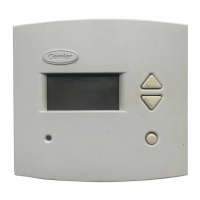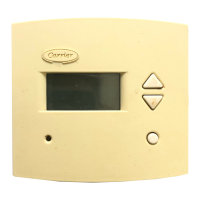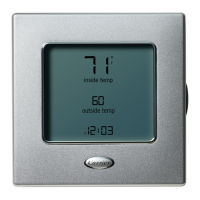SYSTEM MODE SELECTION — System mode is selected
by the associated system controller (monitor thermostat) of
the bypass controller, to control operation of the system heating/
cooling equipment. System Heating Mode is selected when
the equipment heating stages are needed. System Cooling
Mode is selected when the equipment cooling stages are needed.
When the system mode is selected the associated system
controller energizes the corresponding equipment stages and
the bypass controller operates in the bypass damper open
mode.
NOTE: Until the changeover cycle is completed, all zone
dampers modulate based on supply-air temperature.
To determine when the changeover cycle is completed,
the bypass controller compares the bypass damper supply-
air temperature to the changeover set points.
During a system cooling mode, the changeover cycle is
completed when the bypass damper supply-air temperature
is below the changeover cool-down set point.
During a system heating mode, the changeover cycle is
completed when the bypass damper supply-air temperature
is above the changeover warm-up set point.
When the changeover cycle is completed, all zone damp-
ers modulate based on the system mode selected and the by-
pass controller operates in the bypass damper pressure mode.
CHANGEOVER COOL-DOWN SET POINT — The Cool-
Down Set Point function establishes the maximum accept-
able duct temperature that can be sent to the zones during
the changeover cycle when the system is in cooling mode.
The factory setting is 80. The range of acceptable values is
72 to 87.
The Changeover Cool-Down Set Point is the supply-air
temperature that ends the changeover cycle when the system
cooling mode is selected. The bypass damper then assumes
pressure mode operation.
To configure the Cool-Down Set Point, set category 1, op-
tion 1. Use the left information buttons to configure the Cool-
Down Set Point.
CHANGEOVER WARM-UP SET POINT — The Warm-Up
Set Point function establishes the minimum acceptable duct
temperature limit that can be sent to the zones during the
changeover cycle when the system is in heating mode.
The factory setting is 60. The range of acceptable values is
55 to 70.
The Changeover Warm-Up Set Point is the supply-air tem-
perature that ends the changeover cycle when the system heat-
ing mode is selected.
To configure the Warm-Up Set Point, set category 1,
option 2. Use the left information buttons to configure the
Warm-Up Set Point.
Counterclockwise Open Damper Modulation —
The Counterclockwise Open Damper Modulation function
configures the direction that the bypass controller modulates
the bypass damper.
If the Counterclockwise Open Damper Modulation func-
tion is set to ON, the bypass controller modulates the damper
counterclockwise to the open position. The factory setting is
ON.
If the Counterclockwise Open Damper Modulation func-
tion is set to OFF, the bypass controller modulates the damper
clockwise to the open position.
NOTE: The Model ZD (zone circular damper) and Model
RD (rectangular damper) actuators require counterclock-
wise rotation to modulate their dampers to the open
position.
To configure the Clockwise Open Damper Modulation op-
tion, set category 3, option 8. Use the left information but-
tons to set the option ON or OFF.
ZD/RD Actuator — The ZD/RD Actuator option con-
figures the bypass controller to work with a ZD/RD actuator
or a high torque actuator. When the option is set to ON, the
bypass controller will operate the bypass damper with a ZD/RD
actuator. When the option is set to OFF, the bypass control-
ler will operate the bypass damper with a high torque ac-
tuator. The default is ON. A high torque actuator will handle
higher static pressures and comes in two types, an HTA-02
(60 degree actuator) and an HTA-03 (90 degree actuator).
To configure the ZD/RD Actuator option, set category 3,
option 7. Use left information buttons to toggle the option
ON or OFF.
PS (Pressure Sensor) Error Damper Position —
The PS Error Damper Position function establishes the po-
sition to which the bypass controller will modulate its damp-
er(s) during an error condition associated with the pressure
sensor. During the pressure sensor error condition, the by-
pass controller will hold the damper position to maintain sys-
tem static pressure. The factory setting is 5. The range of
acceptable values is 2 to 13.
To configure the PS Error Damper Position function, set
category 3, option 3. Use the left upper and lower informa-
tion buttons to set the position value.
Fan On Delay — The Fan On Delay option is used by
the bypass controller to enhance the operation of the system
when the HVAC equipment controls the indoor fan during
system heating modes. The Fan On Delay option defines how
long the HVAC equipment will delay energizing the indoor
fan after the first stage of heating is energized. The default
is 120 seconds. The range is 0 to 600 seconds.
To configure the Fan On Delay option, set category 3,
option 9. Use the left information buttons to increase or de-
crease the value.
Fan Off Delay — The Fan Off Delay option is used by
the bypass controller to enhance the operation of the system
when the HVAC equipment controls the indoor fan during
system heating modes. The Fan Off Delay option defines how
long the HVAC equipment will energize the indoor fan after
the first stage of heating is deenergized. The default is
120 seconds. The range is 0 to 600 seconds.
To configure the Fan Off Delay option, set category 3,
option 10. Use the left information buttons to increase or
decrease the value.
NOTE: The Fan Off Delay function is also used by the Auto-
Zero function.
DIAGNOSTICS
The bypass controller has diagnostic capabilities for com-
ponents, information, zone comfort, and usage.
Diagnostic problems, called errors, are divided into 3 cat-
egories: Hardware Failure (HF) errors, Storage Failure (SF)
errors, and System Errors (SE).
Error Code Display — An error code representing the
SF, SE, and HF diagnostic functions can be displayed to in-
dicate which error has been declared. The 2 letters located in
the left of the display represent the type of error. The num-
bers located in the right of the display identify the specific
error.
14

